Cyclic alignments and orbital perturbations
We found on the page discussing the fluctuations in the orbit of Ceres that the irregular nature of the variations was caused by alignments between conjunction and aphelion happening at more than one periodicity. This page explains the underlying mechanism and considerably extends the analysis to derive many more detailed results.
Hopefully a diagram, or indeed a series of diagrams, will start to make the process clearer. In Figure 2, Ceres is shown in blue with Jupiter in red. Both bodies are moving in an anti-clockwise direction, as shown by the arrows. Ceres' aphelion is presumed to be at exactly the "12 o'clock" point.
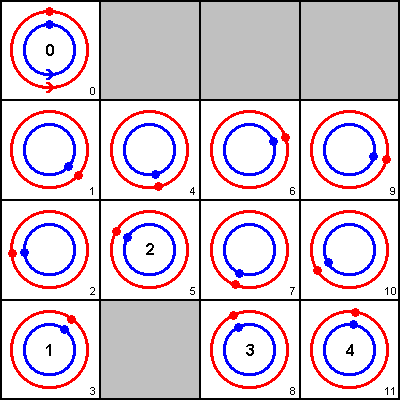 | The sequence starts at top left, with the initial position - the first conjunction exactly at aphelion. Running down the first column are the positions after 1, 2 & 3 further conjunctions [it is to be understood that Ceres completes one full orbit plus almost two-thirds of a further orbit between conjunctions whereas Jupiter moves just the two-thirds]. It can be seen that both bodies are fairly close to the aphelion of Ceres again after the 3rd conjunction and so the effect on the perihelion distance will be quite large. The position after both 2 and 3 more conjunctions is quite similar (diagrams 5 and 6), but on opposite sides of the aphelion point. In fact, confirming the calculation given on the previous page, Ceres is slightly closer to aphelion after 2 conjunctions than after 3 (by just over 8 degrees) so the perturbation effect here will be just slightly greater.
The next "close to aphelion" position arises 3 conjunctions after diagram 5, and the next is 3 conjunctions after that i.e. at diagrams 8 and 11 respectively. In these cases there is no question of the position after just 2 conjunctions being nearer than that after 3. The number of conjunctions between each "greatest perturbation effect" position is thus 3, 2, 3, 3. Note that if (as mentioned above) you deem diagrams 5 and 6 to be effectively the same and therefore want to count position 6 as being the best alignment after position 3, it is clearly the case that the position in diagram 8 is closer to aphelion than that given by diagram 9 and so the 2-conjunction interval still appears: it's just that the overall sequence is now 3, 3, 2, 3. |
While the 4.47 orbit (quasi-)periodicity in the perihelion graph is quite obvious, is the variation in the height of the peaks significant? There seems to be a long-period amplitude variation of 16 or 17 orbits (80yrs or so) but the graphs I had plotted so far did not have enough data points to prove this. To investigate this matter further I decided firstly to construct a mathematical model, in order to eliminate any complications introduced by "the real world", to see if any longer-term patterns emerged. In a similar way to the calculations that produced the diagrams on the previous page, I calculated the angle between aphelion and conjunction for many successive conjunctions and plotted the results - they are shown below.
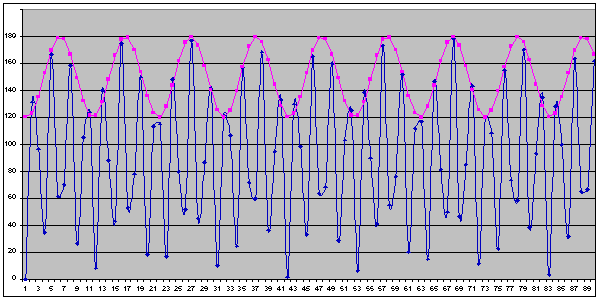
Looking closely at the graph [the blue curve] the first thing to note is that there are very low minima at points 1, 42 & 83. These are 41 conjunctions apart, and 41 conjunctions take 67 orbits i.e. the optimum alignment period described above is noticeable in the form of distinct minima at 41-conjunction intervals. These minima are particularly pronounced because of the almost exact alignment of aphelion and conjunction at those times. Secondly, note that successive minima are separated by either 3 or 2 conjunctions, also as found above. Taking the number of conjunctions between the "smallest minima" [i.e. points 1, 12, 23, 31, 42] the pattern is 3,2,3,3; 3,2,3,3; 3,2,3; 3,3,2,3. This is the total of 41 conjunctions already found, constituted from the basic patterns shown by the orbit diagrams above, with an overall large-scale structure of 11, 11, 8, 11. This pattern is also demonstrated by taking the next set of smallest minima [points 42, 53, 64, 72, 83]. In other words, the graph is quasi-periodic on a large scale, with periods of 11 and 8 conjunctions, as well as on a small scale with periods of 3 and 2 conjunctions, just as suggested by the perihelion-distance graph. The mean period of the sequence of 11, 11, 8 & 11 conjunctions, which I call the "super-period", is 10.25 conjunctions or 16.75 orbits which is 77.13yrs: this is the true periodicity of the long-term fluctuations. The pink curve superimposed on the top edge of the graph shows this: it has a period of 10.25 conjunctions and is an excellent fit to the large-scale oscillations in the data.
The emergence of the longer-term (quasi-)periodicity can also be seen by using orbit diagrams. I have combined all the smaller diagrams shown above into one - at top-left in the next figure. The closest points to aphelion are marked 0, 1, 2, 3 & 4 and correspond to the same situations marked on the smaller diagrams. The green line indicates the position of Ceres' aphelion.
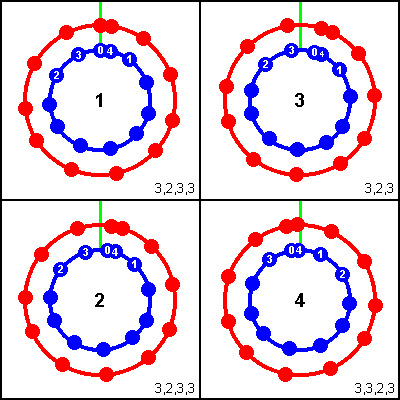 | It can be seen that, as demonstrated above, after 11 conjunctions the position is almost back to the start, but not quite - position 4 is 8.05 degrees before aphelion. Note that position 3 on diagram 1 is 26.87 degrees after aphelion. After a further cycle of 11 conjunctions [during which all the points will shift clockwise by 8.05 degrees] position 3 will only be 18.82 degrees after aphelion while the end position (position 4) will be 16.10 degrees before it - this is shown as diagram 2. The small difference means that when we arrive at position 3 after the first 8 conjunctions of the next cycle it will be closer to aphelion than position 4 would be if the cycle completed (shown by a small number). The cycle will therefore be truncated (as 3, 2, 3) after only these 8 conjunctions, giving diagram 3. The final position is still after aphelion, however (by 10.77 degrees in fact) and so after one more full 11 conjunction cycle it will be just 2.72 degrees after aphelion - this is diagram 4. This is "as good as it gets", as further final positions will clearly move further before aphelion, so the sequence ends here at 11, 11, 8, 11. Note, by the way, that because in the final cycle of 11 conjunctions the start position is just slightly after aphelion, the situation after 3 then 3 conjunctions is now closer to aphelion than the situation after 3 then 2 conjunctions. The sequence of conjunctions for the final cycle is thus 3, 3, 2, 3 i.e. it has both position 1 and position 2 before aphelion. This is the situation described at the end of the explanation for the previous figure, in the case where the alignment in diagram 6 is slightly better than that in diagram 5 due to the initial offset from aphelion. |
These composite diagrams clearly show how the 11, 11, 8, 11 cycle seen in the graph produced by the model comes about so, encouraged by these results, I used Solex to generate a whole new dataset giving the actual angle between the aphelion of Ceres and the point of conjunction for all the conjunctions between 1944 and 2696. And yes, I did need that many values! 41 conjunctions take over 300yrs and I felt I needed to plot more than 1 cycle to prove the point. Also, as it happened, the beginning of a clear cycle didn't happen for the first 90yrs. Plotting the results gave a graph that was so close to that generated theoretically that it would be pointless me including it here! No, really - not only were the most prominent minima in exactly the same place but the depths of the other minima were also the same. However, I did have to allow for the fact that the aphelion of Ceres does actually move (as discovered in the section discussing precession on the previous page), which was an interesting confirmation of this fact! I also plotted the distance from Ceres to Jupiter and found that sometimes this was at a minimum at a conjunction other than that nearest to the aphelion of Ceres: this is because of the varying distance of Jupiter from the Sun, of course, due to the eccentricity of its orbit - more of that later!
The above analysis is somewhat complex (!) so I didn't come upon it exactly overnight. In fact, having no solution to the long-term periodicity for some while, I contacted the eminent Belgian computational astronomer Jean Meeus, mentioned often in these pages. In the first instance, he replied to say he had no idea either! We then had a few misunderstandings about terminology but in the end I think he became convinced that my explanation was correct. During our discussions he suggested looking at the "osculating" values of orbital parameters, as these give a better illustration of how the perturbations are actually affecting the orbit. The osculating orbit is the orbit that would result if the motion of a body was to be undisturbed from this point forward i.e. it shows us what the perihelion distance (for example) would be if the body experienced no more perturbations until it got to the perihelion point. This is something of a mathematical abstraction of course but it should be remembered that the perturbations we are considering have their effect at the opposite side of the orbit from where they occur. The osculating value gives a better illustration of how the perturbations at aphelion are actually affecting the perihelion distance because it removes additional effects experienced on the way to perihelion from aphelion.
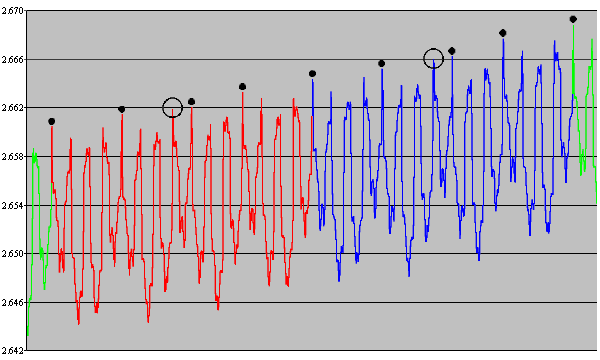
The diagram above shows the osculating perihelion distance each 80days from 1944 to 2621 - over 3000 data points! It has been coloured and marked-up to highlight a number of important points:-
- The red and blue sections are almost perfect replicas of each other. This is because each point on the blue section is exactly the time interval equal to 41 conjunctions from the corresponding point on the red section, confirming my oft-repeated statement that the orbital positions of Ceres and Jupiter (and thus the perturbations) will repeat almost exactly after this interval.
- There are 15 individual maxima (and minima) in each section. Their average period is thus 41/15 conjunctions or 20.57yrs, the basic (quasi-)periodicity I have mentioned above.
- The greatest maxima (marked with black dots) have an irregular spacing, with a mean period of 4 cycles in 41 oppositions i.e. 1 cycle in 10.25 oppositions. This is the additional "quasi-period" of 77.13yrs I have referred to before, which is also well seen at the lower margin of the graph.
- The steady increase in (mean) perihelion distance is not the same phenomenon as the one I referred to earlier in the section on precession - this concerned the point on the orbit at which perihelion occured. The increase in actual distance is due to a very slow overall decrease in the mean eccentricity of the orbit of Ceres over this time-period as a result of the cumulative effect of perturbations on the other orbital parameters.
- The maxima marked with the circles correspond to the unusually small Ceres-to-Jupiter distances at conjunction that I mentioned above. It can be seen that they are larger than the maxima in the equivalent position in other cycles, indicating that the decreased distance has indeed resulted in a greater perturbation. These maxima are, again, separated by exactly the time interval equal to 41 conjunctions (as might be expected). That this effect is caused by the varying distance of Jupiter can be seen by considering the celestial longitude of these anomalous conjunctions - 9.6 and 12.2 deg respectively. The longitude of Jupiter's perihelion is around 15.6deg over the period of my study and there were only four conjunctions occurring near this point: two before it and two after it. Each pair was separated by the same 41-conjunction interval. The two before it were, on average, closer to the perihelion point of Jupiter than the two after (-5.9 & -3.5 degrees away compared to +5.2 & +7.1 degrees) and of course the two after were also further from the aphelion of Ceres (whose mean longitude was 338 degrees) so would have a slightly lesser perturbation effect anyway. It would thus seem likely that the two conjunctions happening just before Jupiter's perihelion would be the ones to be most affected by the nearer position of Jupiter, and indeed this is so - these were the conjunctions noted above.
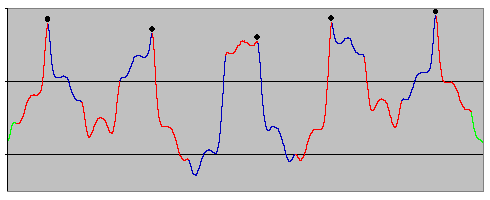 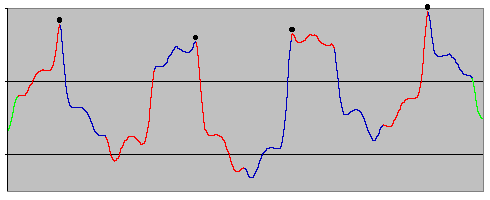 | These diagrams are expanded versions of the first and third cycles of the blue section of the figure above. The maxima are again shown by black dots but this time the red and blue sections mark the periods from one conjunction to the next. The first thing to note is that maxima do indeed occur at the time of conjunctions. It is clear that the pattern of number of conjunctions between the maxima is 3,3,2,3 in the upper diagram and 3,2,3 in the lower diagram, as calculated by me previously i.e. a total of 11 and 8 conjunctions respectively. Referring back to the first figure, the second and fourth cycles of the blue section are clearly very similar to the first i.e. they contain 11 conjunctions. The overall pattern of each coloured section is thus seen to be 11,11,8,11, also as calculated previously. This pattern exactly accounts for the irregular spacing of the greatest maxima, the mix of 1 period of 8 conjunctions (60.20yrs) and 3 periods of 11 conjunctions (82.77yrs) leading to the 77.13yr additional (quasi-)periodicity stated. In addition, taken over the entire cycle of 3323/3323/323/3233, the mix of 4 periods of 2 conjunctions (15.05yrs) and 11 periods of 3 conjunctions (22.57yrs) again gives the 20.57yr basic (quasi-)periodicity. |
So, the "real-life" data confirms that the short-period and long-period variations are both due to the same cause - a consequence of the presence of alignment cycles of different periodicity. The 20.57yr (4.47 orbit) period is due to the need for cycles of both 3 and 2 conjunctions in order to synchronise conjunctions with aphelion, and the 77.13yr period is caused by there being cycles of 11 and 8 conjunctions in the angular distance between aphelion and conjunctions (and thus in the strength of the perturbing force). This is all very well as far as it goes, but can we go further and use the relationships discovered to find a detailed explanation for the "shape" of the maxima as well as their periodicities? The answer, as with many things in life, is "yes and no"! To make progress, a diversion into orbital mechanics is required, however.
The mechanism of orbit change due to perturbations
One might naively think that a perturbation simply "stretches" the orbit as the smaller body is pulled slightly towards the larger. This cannot be true, however, as if it were how could the perihelion ever decrease? In fact, perturbations affect orbits by changing the speed of the orbiting body. In the present case, if Ceres is moving towards Jupiter (i.e. it is approaching conjunction) then the gravitational attraction exerted by Jupiter is in the same direction as Ceres' motion so it will speed up. Conversely, if Ceres is moving away from Jupiter (i.e. it is leaving conjunction) the force will be against its motion so it will slow down. Orbital mechanics tells us that an increase in orbit speed will lead to an increase in orbit distance of that part of the orbit diametrically opposite to where the speed increase occurred - for example, a speed increase at aphelion will lead to an increase in the perihelion distance. In a similar way, a speed decrease will lead to a decrease in orbit distance. I've put the proof of this principle (plus a lot more discussion of related topics!) on a separate page, so to learn more about orbital dynamics click here.
When Ceres is approaching conjunction it will be speeded up by Jupiter and so, as conjunction is close to aphelion in the case we are considering, its osculating perihelion distance will increase - I say "osculating perihelion distance" because of course it hasn't got to perihelion yet so we can't speak about the actual distance. The speed-up will get greater as conjunction approaches and the distance between Ceres and Jupiter decreases, so the [osculating] perihelion distance will get steadily larger. Those who have read the section on Orbital Dynamics will realise that there will also be a secondary effect - because Jupiter is pulling Ceres towards it to some extent as well as speeding it up the actual aphelion distance will also increase slightly. As Ceres then moves away from conjunction it will be slowed down again and so the reverse effect will happen - the [osculating] perihelion distance will steadily decrease.
The magnitude of the speed-up and slow-down (and hence the changes in osculating perihelion distance) will only be the same if conjunction is exactly at aphelion, however. The key point here is not so much the Ceres-Jupiter distance but the fact that, as I have often said, Ceres will be going considerably slower at aphelion. Thus if the conjunction is after aphelion, during the period before conjunction Ceres will be moving slowly and hence will be "under the influence" of Jupiter for a greater time. This will produce a greater slow-down before conjunction than after, when it will be speeding up and hence hurrying away from Jupiter. In this circumstance the perihelion distance will thus increase more than it decreases. Conversely, if conjunction is before aphelion there will be a greater decrease than increase. This part of the analysis was brought to my attention by Jean Meeus during my discussions with him, so I can't claim any credit for this result!
All these cases are shown in the diagrams above - particularly in the upper one. The conjunctions in the first and last cases are almost exactly at aphelion and so the shape of the peak is reasonably symmetrical. The second peak has the shape for "conjunction before aphelion" and the fourth for "conjunction after aphelion" [the middle one is fairly flat as neither of the nearby conjunctions is particularly close to aphelion in the first place]. Referring to the orbit diagrams (rather a long way up the page now!) we see that this is indeed the actual situation. There is also evidence of the secondary effect I mentioned above, in the low part of the graph between the third and fourth peaks on the upper diagram and between the second and third peaks on the lower one. The conjunctions happening here are almost exactly at perihelion. As would be expected, this has almost no effect on the perihelion distance. There is a slight "bump", however, and this is caused by Jupiter directly pulling Ceres slightly towards it. The effect is only temporary though because (as was shown in the section on Orbital Dynamics) the ultimate effect of this pull is, rather strangely, to slightly reduce the perihelion distance.
This analysis can explain the major features around aphelion and perihelion, but the effect of conjunctions occurring at other places on the orbit is more complex and thus harder to analyse. For example, it is notable that there is an upwards fluctuation near to the middle of each coloured sector i.e. something is happening between conjunctions. As Jupiter will be maximally distant from Ceres at these times it is not clear what might be causing these variations. They may simply be evidence of the orbit "settling down" as it moves from one shape to another, but I can't be sure - even I can't be expected to explain everything!





